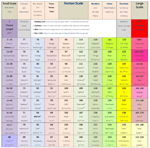We have been studying simple math and simple geometries from the smallest possible measurement of a length to the largest (Reference #2). It appeared to some of the students, based on this work, that the universe is obviously finite. They have been told that intellectually and historically, it is an open question. For them, “Make a choice and see where it takes you.”
These students also conclude, “Only God is Infinite. All things within space and time are finite.” (Reference #3) When asked about all the universals-and-constants and space-and-time, the concurrence is that these are the access paths, interconnections and transformations between the Finite and the Infinite.
For the best of these students, asking the question, “What is the Infinite?” is like asking the question, “Who is God?” And, they have answers.
 Of course, as a result of a little coaching, they say, “First, God is Perfect.” When asked, “What is perfection?” they echo their coach: “Perfection is order-continuity, relations-symmetry and dynamics-harmony, all rolled into one.” (Reference #4) That amounts to an understanding of the Infinite without importing all the related history and revelation from the various faith statements with our very short history throughout our little world. The Finite is another story. We turn to Euclid for inspiration to provide the academic and religious communities with our simple observations and assumptions.
Of course, as a result of a little coaching, they say, “First, God is Perfect.” When asked, “What is perfection?” they echo their coach: “Perfection is order-continuity, relations-symmetry and dynamics-harmony, all rolled into one.” (Reference #4) That amounts to an understanding of the Infinite without importing all the related history and revelation from the various faith statements with our very short history throughout our little world. The Finite is another story. We turn to Euclid for inspiration to provide the academic and religious communities with our simple observations and assumptions.
Hardly postulates and axioms, our statements are a praxis in-search-of theoria:
- Interior geometries. There are basic geometries within basic geometries. Two of the most simple platonic solids are the tetrahedron and octahedron. The simple interior structures can become exceedingly complex. (Reference #5)
- A domain that remains largely unexplored. We assume that among its many possible descriptions, the Planck Length could be taken to be a vertex. If so, there are over a million-trillion vertices within just the 60th base-2 exponential notation and then another two million-trillion with the 61st notation. (Reference #6) There are over 60 virtually unexplored domains from the Planck Length to particle physics.
- A range of notations. There are around 205.11 base-2 exponential notations (doublings, domains, layers or steps) within the Known Universe. (Reference #7)
- There are imperfect geometries. These appear to begin within the five tetrahedral “pentastar’ cluster and these are extended within the icosahedron and the Pentakis dodecahedron. It appears that this imperfection was first recorded within history in 1958 (Frank & Kaspers).
- The universe can be perfectly tiled. The simplest 3D tiling is with tetrahedral-octahedral-tetrahedral chains and clusters within those 205.11 layers. Also, within the octahedron are four hexagonal plates at 60 degree angles around the center point. These each extend as planes with abutting octahedrons for 2D tiling. This is the simple beginning of possible ways to tile the universe. For more, we turn to Penrose, Conway, and many others.
- In theory, the Planck Length is indivisible. It is, however, a specific length. If that conclusion is taken as a given, the Planck Length could be considered the indivisible unit in the historic Theory of Indivisibles and the start of the Finite and the transformation between the Finite and Infinite.
If these statements are taken as a given, then what kind of universe and what kind of science do we have? Should we re-examine the use of infinity throughout the ages going back to the ancient Greeks? Should we reconsider the theory of indivisibles? And, perhaps we should even reconsider the very nature of the Big Bang and its theory.
Of course, that is our agenda (Reference #8), our current focus for the immediate future.
References:
1. An associated article within LinkedIn titled, Order in the Universe
2. One of the earliest reflections on this work: https://bigboardlittleuniverse.wordpress.com/
3. Initially written in November 2012, this article was first posted on March 2013 within WordPress: https://bigboardlittleuniverse.wordpress.com/2013/03/21/belief/
4. In light of those constants, universals and the finite-infinite relation, the nature of perfection seems to follow: http://smallbusinessschool.org/page1695.html
5. Examining basic structure in basic ways: http://smallbusinessschool.org/page2546.html#TetraInside
6. A new domain to explore with exponential numbers of vertices: http://doublings.wordpress.com/2013/04/17/60/
8. An analysis of 15 key points: http://doublings.wordpress.com/2014/05/08/15/
The TinyURL for this page is: http://tinyurl.com/finitePlanck



